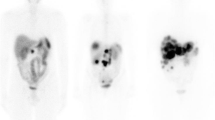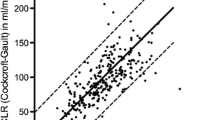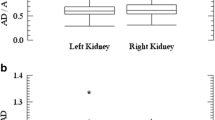Abstract
Peptide receptor radionuclide therapy (PRRT), with 90Y-DOTATOC and 177Lu-DOTATATE as most clinically used radiopeptides, is widely used in the management of metastatic neuroendocrine tumors. With respect to radiation dosimetry, the kidneys are the critical organ for 90Y-DOTATOC. Renal irradiation is significant because of reabsorption of the radiopeptide from the proximal tubuli and the resulting retention in the interstitium, mainly in the inner cortical zone. The high energy and consequently wide range in tissue of the yttrium-90 beta particle result in high absorbed doses to the kidney cortex and medulla. Accurate renal dosimetry can help minimizing radiation nephropathy. We report a case of a 69-year-old candidate for PRRT with an acceptable kidney function at the time of screening. When performing 111In-octreotide pretreatment dosimetry 3 weeks later, we observed a drastic deterioration in kidney function, caused by undisclosed non-steroidal anti-inflammatory drug intake. The calculated kidney biological effective dose (BED) was 153 Gy after four projected cycles. PRRT was canceled as our full-course BED limit is 37 Gy and the patient was switched to morphine analgesics. Renal function normalized after 3 months and repeated dosimetry yielded an acceptable kidney BED of 28 Gy after four projected cycles (7 Gy/cycle). This case emphasizes that acute kidney insufficiency can yield toxic kidney doses in a single therapy cycle, with an inherent risk of persistent renal insufficiency. All clinical factors which might influence kidney function should be verified at screening and before PRRT administration.


Similar content being viewed by others
References
Bodei L, Cremonesi M, Grana CM, Chinol M, Baio SM, Severi S, et al. Yttrium-labelled peptides for therapy of NET. Eur J Nucl Med Mol Imaging. 2012;39(Suppl 1):S93–102. Epub 2012/03/06.
Kwekkeboom DJ, Mueller-Brand J, Paganelli G, Anthony LB, Pauwels S, Kvols LK, et al. Overview of results of peptide receptor radionuclide therapy with 3 radiolabeled somatostatin analogs. J Nucl Med. 2005;46(Suppl 1):62S–6S. Epub 2005/01/18.
Waldherr C, Pless M, Maecke HR, Schumacher T, Crazzolara A, Nitzsche EU, et al. Tumor response and clinical benefit in neuroendocrine tumors after 7.4 GBq (90)Y-DOTATOC. J Nucl Med. 2002;43(5):610–6. Epub 2002/05/08.
De Jong M, Valkema R, Van Gameren A, Van Boven H, Bex A, Van De Weyer EP, et al. Inhomogeneous localization of radioactivity in the human kidney after injection of [(111)In-DTPA]octreotide. J Nucl Med. 2004;45(7):1168–71. Epub 2004/07/06.
Barone R, Borson-Chazot F, Valkema R, Walrand S, Chauvin F, Gogou L, et al. Patient-specific dosimetry in predicting renal toxicity with (90)Y-DOTATOC: relevance of kidney volume and dose rate in finding a dose-effect relationship. J Nucl Med. 2005;46(Suppl 1):99S–106S. Epub 2005/01/18.
de Jong M, Krenning E. New advances in peptide receptor radionuclide therapy. J Nucl Med. 2002;43(5):617–20. Epub 2002/05/08.
Bodei L, Cremonesi M, Grana C, Rocca P, Bartolomei M, Chinol M, et al. Receptor radionuclide therapy with 90Y-[DOTA]0-Tyr3-octreotide (90Y-DOTATOC) in neuroendocrine tumours. Eur J Nucl Med Mol Imaging. 2004;31(7):1038–46. Epub 2004/05/20.
Baechler S, Hobbs RF, Prideaux AR, Wahl RL, Sgouros G. Extension of the biological effective dose to the MIRD schema and possible implications in radionuclide therapy dosimetry. Med Phys. 2008;35(3):1123–34. Epub 2008/04/15.
Teunissen JJ, Kwekkeboom DJ, Krenning EP. Quality of life in patients with gastroenteropancreatic tumors treated with [177Lu-DOTA0, Tyr3]octreotate. J Clin Oncol. 2004;22(13):2724–9. Epub 2004/07/01.
Bodei L, Cremonesi M, Ferrari M, Pacifici M, Grana CM, Bartolomei M, et al. Long-term evaluation of renal toxicity after peptide receptor radionuclide therapy with 90Y-DOTATOC and 177Lu-DOTATATE: the role of associated risk factors. Eur J Nucl Med Mol Imaging. 2008;35(10):1847–56. Epub 2008/04/23.
Imhof A, Brunner P, Marincek N, Briel M, Schindler C, Rasch H, et al. Response, survival, and long-term toxicity after therapy with the radiolabeled somatostatin analogue [90Y-DOTA]-TOC in metastasized neuroendocrine cancers. J Clin Oncol. 2011;29(17):2416–23. Epub 2011/05/11.
Author information
Authors and Affiliations
Corresponding author
Rights and permissions
About this article
Cite this article
Van Binnebeek, S., Baete, K., Terwinghe, C. et al. Significant impact of transient deterioration of renal function on dosimetry in PRRT. Ann Nucl Med 27, 74–77 (2013). https://doi.org/10.1007/s12149-012-0651-y
Received:
Accepted:
Published:
Issue Date:
DOI: https://doi.org/10.1007/s12149-012-0651-y




